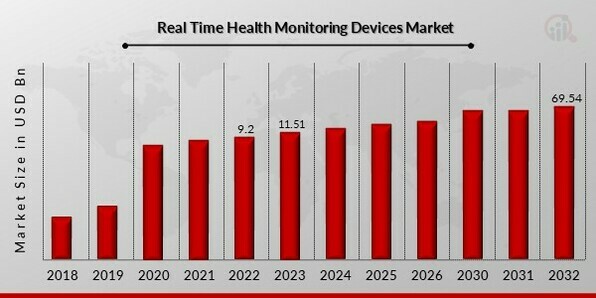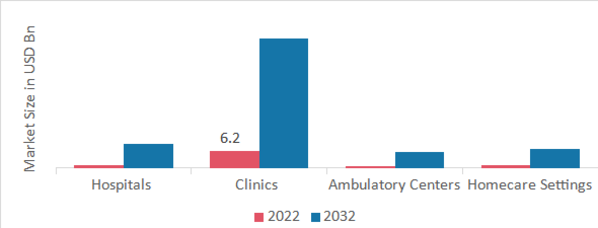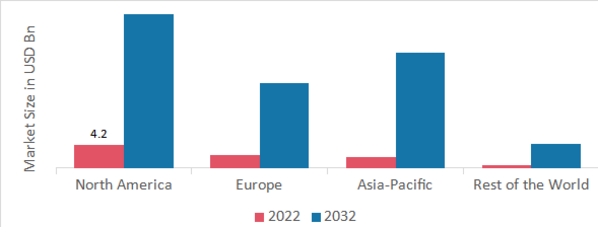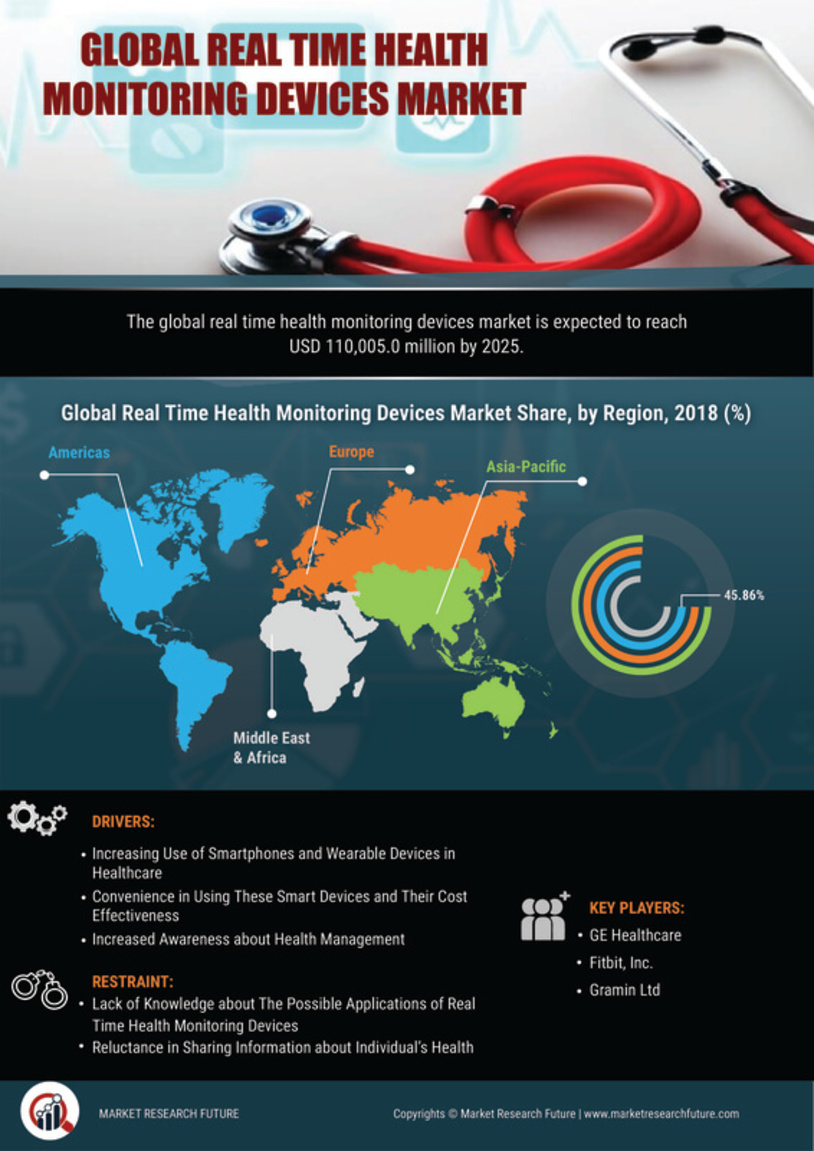Global Real Time Health Monitoring Devices Market Overview
Real Time Health Monitoring Devices Market Sizewas valued at USD 9.2Billion in 2022. The Real Time Health Monitoring Devices Market industry is projected to grow from USD11.51Billion in 2023 to USD 69.54 Billion by 2032, exhibiting a compound annual growth rate (CAGR) of 25.20% during the forecast period (2023 - 2032).Increasing usages of modern smart phones and various wearable devices in several healthcare, convenience in applying these smart devices, their proper cost-effectiveness, and completely increased awareness about general health management are a few of the vital factors which are propelling the growth of market the key market drivers enhancing the market growth.
 Source: Secondary Research, Primary Research, MRFR Database and Analyst Review
Source: Secondary Research, Primary Research, MRFR Database and Analyst Review
Real Time Health Monitoring Devices Market Trends
- Growing Integration of AI and Machine Learning is driving the market growth
Market CAGR for real time health monitoring devices is being driven by the real-time health monitoring devices market is the integration of artificial intelligence (AI) and machine learning (ML) algorithms. Al-powered devices can process vast amounts of data collected from sensors and wearable, providing accurate and timely insights into an individual's health status. Machine learning algorithms continuously improve their accuracy and efficiency over time, leading to personalized and precise health monitoring.
Additionally, the rise of chronic diseases, such as diabetes, hypertension, and cardiovascular disorders, has fueled the demand for remote patient monitoring (RPM) solutions. RPM enables healthcare providers to monitor patients' vital signs and health parameters remotely, reducing the need for frequent hospital visits and improving overall patient outcomes.
Real-time health monitoring devices equipped with RPM capabilities transmit patient data to healthcare professionals in real-time, facilitating early detection of any deviations from normal health patterns. These devices can also automatically alert healthcare providers in case of emergencies, ensuring timely medical intervention. By enabling proactive healthcare management, RPM not only improves patients' quality of life but also helps in reducing healthcare costs associated with hospital admissions and emergency care.
The integration of wearable technology with telemedicine platforms represents another significant trend in the real-time health monitoring devices market. Telemedicine has witnessed a surge in adoption due to its convenience and accessibility, especially during the COVID-19 pandemic when in-person healthcare visits were restricted. Real-time health monitoring devices, when combined with telemedicine solutions, offer a comprehensive healthcare ecosystem. Patients can connect with healthcare providers remotely, sharing their real-time health data for immediate assessment and diagnosis. This integration enhances healthcare professionals' ability to provide accurate recommendations and treatment plans, improving patient engagement and adherence to prescribed therapies.
The real-time health monitoring devices market is witnessing remarkable growth, driven by trends such as the integration of Al and machine learning, the adoption of remote patient monitoring for chronic diseases, and the integration of wearable technology with telemedicine. These trends are revolutionizing the healthcare industry by enabling individuals to take charge of their health in real-time and facilitating more personalized and proactive healthcare management. As technology continues to advance and consumer demand for health monitoring devices increases, we can expect further innovations and transformative changes in the real- time health monitoring sector. It drives the Real Time Health Monitoring Devices Market revenue.
Real Time Health Monitoring Devices MarketSegment Insights
Real Time Health Monitoring Devices Type Insights
The Real Time Health Monitoring Devices Market segmentation, based on type includes Wearable Devices, Connected Home Health Medical Devices. The wearable devices segment dominated the market, accounting for 35% of market revenue (78.48 Billion). Wearable health monitoring devices, such as smart watches, fitness bands, and smart clothing, are among the most prominent segments. These devices continuously track various physiological parameters, including heart rate, blood-pressure, sleep patterns, and physical activity. The integration of advanced sensors and data analytics capabilities has significantly improved their accuracy and usability.
Real Time Health Monitoring DevicesForm Insights
The Real Time Health Monitoring Devices Market segmentation, based on End-User, includes Hospitals, Clinics, Ambulatory Centers, and Homecare Settings. The clinics category generated the most income (70.4%). These institutions rely on these devices to monitor patients' vital signs continuously, especially in critical care units. Real-time monitoring aids in early detection of any abnormalities and allows for timely interventions, ultimately improving patient outcomes.
Figure1: Real Time Health Monitoring Devices Market, by End User,2022&2032(USD Billion)

Source: Secondary Research, Primary Research, MRFR Database and Analyst Review
Real Time Health Monitoring Devices Regional Insights
By region, the study provides the market insights into North America, Europe, Asia-Pacific and Rest of the World. The North American Real Time Health Monitoring Devices Market area will dominate this market, owing to the region's robust healthcare infrastructure and high disposable income. The United States and Canada are the major contributors, with an increasing adoption of wearable fitness trackers and smart watches.
Further, the major countries studied in the market report are The US, Canada, German, France, the UK, Italy, Spain, China, Japan, India, Australia, South Korea, and Brazil.
Figure2: Real Time Health Monitoring Devices Market SHARE BY REGION 2022 (USD Billion)

Source: Secondary Research, Primary Research, MRFR Database and Analyst Review
EuropeReal Time Health Monitoring Devices Market accounts for the second-largest market share due to increasing focus on preventive healthcare and fitness among the population. Further, the GermanReal Time Health Monitoring Devices Marketheld the largest market share, and the UK Real Time Health Monitoring Devices Market was the fastest growing market in the European region
The Asia-Pacific Real Time Health Monitoring Devices Market is expected to grow at the fastest CAGR from 2023 to 2032. This is due to rising awareness about health and fitness, coupled with the expanding smart phone penetration, accelerates the market's expansion in the region. Moreover, China’s Real Time Health Monitoring Devices Market held the largest market share, and the Indian Real Time Health Monitoring Devices Market was the fastest growing market in the Asia-Pacific region.
Real Time Health Monitoring DevicesKeyMarket Players& Competitive Insights
Leading market players are investing heavily in research and development in order to expand their product lines, which will help the Real Time Health Monitoring Devices Market, grow even more. Market participants are also undertaking a variety of strategic activities to expand their footprint, with important market developments including new product launches, contractual agreements, mergers and acquisitions, higher investments, and collaboration with other organizations. To expand and survive in a more competitive and rising market climate, Real Time Health Monitoring Devicesindustry must offer cost-effective items.
Manufacturing locally to minimize operational costs is one of the key business tactics used by manufacturers in the Real Time Health Monitoring Devices industry to benefit clients and increase the market sector. In recent years, the Real Time Health Monitoring Devicesindustry has offered some of the most significant advantages to medicine. Major players in the Real Time Health Monitoring Devices Market, including GE Healthcare (U.K.), Qualcomm (U.S.), Jawbone Inc. (U.S.), Withings SA (France), Fitbit Inc. (U.S.), Garmin Ltd. (Switzerland), and others, are attempting to increase market demand by investing in research and development operations.
Qualcomm is known for developing innovations that push the boundaries of what's possible across devices and networks to enable next-generation experiences and drive digital transformation across industries. Decades of extensive research fuels every one of our extraordinary inventions and our one technology roadmap allows us to efficiently scale our portfolio of industry- leading mobile innovations to support virtually every device connected to the cloud. Goldman Sachs predicts that generative Al could raise GDP by almost $7 trillion over a 10-year period. Hybrid Al, which distributes processing between the device and the cloud, is a key part of achieving this growth across the economy. On-device Al processing offers many benefits, including user privacy, security, immediacy, enhanced reliability, and cost. The pace, scale, and high integration that drive the mobile industry are allowing Al to scale to billions of devices. The power-efficient Al technology that we research and develop is fundamental across industries and products, spanning from smart phones, PCs, and XR to loT and automotive.
Jawbone is a 460MW onshore wind power project located in Montana, United States. It is being developed by Gaelectric LLC; Seventus LLC. The project is currently under construction. The project is expected to enter commercial operation in 2023. The project is owned by Gaelectric LLC; Seventus LLC. Jawbone profile includes core details such as plant name, technology, capacity, status, plant proponents (owners, developers, etc.), owner stakes, etc as well as key operational data including generation, year online, decommissioning year, capital expenditure, etc. Details on project-specific contacts along with relevant news, deals, and contracts are also provided through the plant profile. This is an on-demand report that will be delivered upon request. The report will be delivered within 1 business day of the purchase, excluding weekends and holidays. Certain sections of the report may be removed or altered based on data availability and relevance.
Key Companies in the Real Time Health Monitoring Devices Marketinclude
Real Time Health Monitoring Devices Industry Developments
March 2023:A study published in the journal Nature reported that wearable devices can be used to accurately track sleep apnea. This finding could help to improve the diagnosis and treatment of this sleep disorder.
February 2023:Apple announced that it will be releasing a new generation of Apple Watch with new features, including a built-in ECG sensor and a blood oxygen sensor.
March 2021:Garmin acquired Aero Data, a Scottsdale AZ based company that provides aircraft performance software for over 135 airlines worldwide. The company will continue to operate under the Aero Data brand.
Real Time Health Monitoring Devices Market Segmentation
Real Time Health Monitoring Devices Market Type Outlook
Real Time Health Monitoring Devices Market End User Outlook
-
Hospitals
-
Clinics
-
Ambulatory Centers
-
Homecare Settings
Real Time Health Monitoring Devices Market Regional Outlook
-
Germany
-
France
-
UK
-
Italy
-
Spain
-
Rest of Europe
-
Asia-Pacific
-
China
-
Japan
-
India
-
Australia
-
South Korea
-
Australia
-
Rest of Asia-Pacific
-
Rest of the World
-
Middle East
-
Africa
-
Latin America
|
Report Attribute/Metric
|
Details
|
|
Market Size2022
|
USD 9.2Billion
|
|
Market Size 2023
|
USD 11.51Billion
|
|
Market Size2032
|
USD 69.54 Billion
|
|
Compound Annual Growth Rate (CAGR)
|
25.20% (2023-2032)
|
|
Base Year
|
2022
|
|
Market Forecast Period
|
2023-2032
|
|
Historical Data
|
2018- 2022
|
|
Market Forecast Units
|
Value (USD Billion)
|
|
Report Coverage
|
Revenue Forecast, Market Competitive Landscape, Growth Factors, and Trends
|
|
Segments Covered
|
Type, End User, and regions
|
|
Geographies Covered
|
North America, Europe, AsiaPacific, and the Rest of the World
|
|
Countries Covered
|
The US, Canada, German, France, UK, Italy, Spain, China, Japan, India, Australia, South Korea, and Brazil
|
|
Key Companies Profiled
|
GE Healthcare (U.K.), Qualcomm (U.S.), Jawbone Inc. (U.S.), Withings SA (France), Fitbit Inc. (U.S.), Garmin Ltd. (Switzerland).
|
|
Key Market Opportunities
|
The increasing dependence on the Real Time Health Monitoring Devices
|
|
Key Market Dynamics
|
Daily increasing usages of modern smart phones
Various wearable devices in several healthcare Convenience in applying these smart devices, their proper cost-effectiveness
|
Real Time Health Monitoring Devices Market Highlights:
Frequently Asked Questions (FAQ) :
The Real Time Health Monitoring Devices Marketsize was valued at USD 9.2Billion in 2022.
The market is projected to grow at a CAGR of 25.20%during the forecast period, 2023-2032.
North America had the largest share in the market
The key players in the market are GE Healthcare (U.K.), Qualcomm (U.S.), Jawbone Inc. (U.S.), Withings SA (France), Fitbit Inc. (U.S.), Garmin Ltd. (Switzerland)
The Wearable Devices category dominated the market in 2022.
The Clinics based has the largest share in the market.





 Source: Secondary Research, Primary Research, MRFR Database and Analyst Review
Source: Secondary Research, Primary Research, MRFR Database and Analyst Review






















